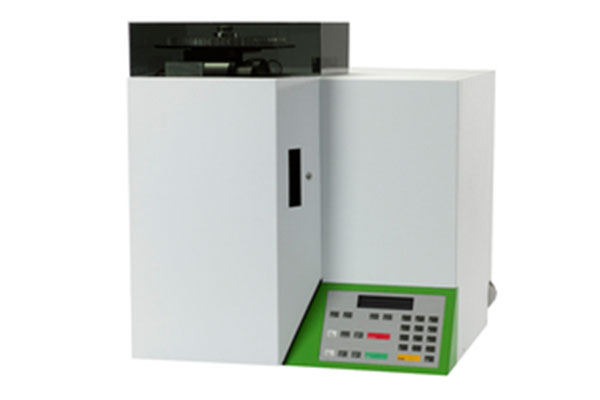
The 2400 Series II CHNS/O Elemental Analyzer
The PerkinElmer® 2400 Series II CHNS/O Elemental Analyzer (2400 Series II) is a proven instrument for the rapid determination of the carbon, hydrogen, nitrogen, sulfur or oxygen content in organic and other types of materials. It has the capability of handling a wide variety of sample types in the field of pharmaceuticals, polymers, chemicals, environmental and energy, including solids, liquids, volatile and viscous samples.
Overview
The analyzer is capable of operating in three modes: CHN, CHNS and Oxygen, is fully automated, and includes a 60 position auto sampler.
The system includes user-friendly EA Data Manager Software which adds powerful capabilities that assist in streamlining data collection and analyses.
With the analyzer System you can:
- Determine weight percent carbon, hydrogen, nitrogen, sulfur or oxygen in a variety of sample types
- Collect and store data
- Perform advanced calculations and/or recalculate results
- Run queries, generate statistics and create reports
- Operate in 3 modes: CHN, CHNS and Oxygen
In addition, the PC compatible, Windows-based interface allows users to track instrument history and monitor components, while adhering to 21 CFR Part 11 compliance for regulated environments.
Principle
The determination of C, H, N and S.
In the CHNS operating mode the analyzer employs a combustion method to convert the sample elements to simple gasses (CO2, H2O, N2 and SO2). The sample is first oxidized in a pure oxygen environment using classical reagents. Products produced in the combustion zone include CO2, H2O, N2 and SO2. Elements, such as halogens, are removed in the reduction zone. The resulting gasses are homogenized and controlled to exact conditions of pressure, temperature, and volume. The homogenized gasses are allowed to de-pressurize through a column where they are separated in a stepwise steady-state manner and detected as a function of their normal conductivities.
Oxygen analysis
The sample is pyrolyzed in a helium/hydrogen environment at 1000 degrees C, over platinized carbon, where the pyrolyzed oxygen products of reaction are converted to carbon monoxide. The carbon monoxide and other gasses pass through a scrubber trap where acid gasses and water are removed. The resulting gasses are homogenized and controlled to exact conditions of pressure, temperature and volume. The homogenized gasses are allowed to de-pressurize through a column where they are separated in a stepwise steady-state manner and detected as a function of their thermal conductivities.
A helium/hydrogen (or argon/hydrogen) carrier gas mixture is used in this procedure to enhance the conversion of oxygen to carbon monoxide. The helium/hydrogen gas supply requires a hydrogen regulator with a safety blow-out valve. As a safety precaution for these operating conditions, the oxygen supply line used for CHN and CHNS determinations should, of course, be disconnected at the analyzer.
Strengths
Optimized combustion flexibility for best performance
Combustion is the most critical step to the success of the measurements and ultimately affects the accuracy and precision of the final result: the weight percent of the element or elements being measured. The system provides advanced combustion conditions of temperature, time and available oxygen (or pyrolysis gas in the case of Oxygen mode). The user has the flexibility to increase the sample’s combustion time in the oxygen atmosphere as well as the amount of oxygen that is introduced allowing for complete combustion of virtually any type of sample.
Frontal chromatography for highest reliability
There is selective retention of the gases to produce a steady-state, stepwise signal rather than a peak signal. This technique allows for a simpler, more reliable and accurate determination of the combustion gases than other CHNS/O systems which use a peak separation method.
Gas control zone
The thorough mechanical homogenization of product gases under the controlled conditions of pressure, temperature and volume are important in order to achieve the most precise results.
Upgradeability
The analyzer can be upgraded at any time to add additional mode capability to suit the needs of the laboratory.
Automated weight entry
Accurate weighing of samples is a prerequisite for organic elemental analysis since results are presented on a weight percent basis. To avoid transcription errors, the system provides automatic weight entry from the cost-effective PerkinElmer AD-6 Autobalance as well as other ultra microbalances. Using proven PerkinElmer balance technology, the AD-6 ultra mircobalance provides exceptional resolution and accuracy for the best results.
Multiple modes of operation
The analyzer offers multiple analysis options: CHN, CHNS or Oxygen mode. As a user, you may choose one or more options to meet your laboratory’s needs. Changeover to different modes of operation only requires a few simple steps. The optional Column Switching Accessory (CSA) makes switching to the Oxygen mode very convenient.
Laboratory efficiency
The analyzer offers fast analysis times, optimizing efficiency and precision. A typical CHN analysis is accomplished in under six minutes, CHNS in eight minutes and oxygen in four minutes.
A unique wake-up routine allows the automatic equilibration and standardization of the 2400 Series II at an operator-selected date and time. This feature allows the system to be ready when you are.
A 60-position autosampler allows unattended operation night or day. The autosampler design has been tested through millions of cycles, both in accelerated quality assurance testing, and most importantly, in labs like yours throughout the world.
Diagnostic routines monitor electronic and pneumatic components for proper operation and alert the operator in the rare event that a failure is encountered. A program-mable gas saver valve allows for the automatic reduction of carrier gas flow rate when the analyzer is not in use.
Software capabilities
The EA 2400 Data Manager is SQL-based software. It allows the use of a standard PC to collect and store data, perform advanced calculations, recalculate a result, run queries (searches), generate statistics, create reports and archive data. For regulated environments, it is compliant with 21 CFR